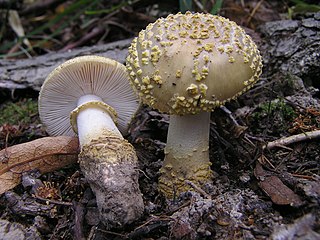Related Research Articles

Lepiota is a genus of gilled mushrooms in the family Agaricaceae. All Lepiota species are ground-dwelling saprotrophs with a preference for rich, calcareous soils. Basidiocarps are agaricoid with whitish spores, typically with scaly caps and a ring on the stipe. Around 400 species of Lepiota are currently recognized worldwide. Many species are poisonous, some lethally so.

The Agaricaceae are a family of basidiomycete fungi and include the genus Agaricus, as well as basidiomycetes previously classified in the families Tulostomataceae, Lepiotaceae, and Lycoperdaceae.

Omphalotus is a genus of basidiomycete mushroom, in the family Marasmiaceae, formally circumscribed by Victor Fayod in 1889. Members have the traditional cap and stem structure. They are saprobic, and fruit in clumps on the ground, adjacent to host trees. The best known and type species is the jack-o'-lantern mushroom (Omphalotus olearius). Species of Omphalotus have been mistaken for chanterelles. All Omphalotus species are presumed poisonous, causing gastrointestinal symptoms. Some Omphalotus species have bioluminescent properties.

Pholiotina is a genus of small agaric fungi. It was circumscribed by Swiss mycologist Victor Fayod in 1889 for Conocybe-like species with partial veils. The genus has since been expanded to include species lacking partial veils.

Hans Schinz was a Swiss explorer and botanist who was a native of Zürich.
Barcheria is a fungal genus in the family Agaricaceae. This is a monotypic genus, containing the single sequestrate species Barcheria willisiana, found in western Australia.

Gyrophragmium is a genus of fungi in the family Agaricaceae. The genus was circumscribed by French botanist Camille Montagne in 1843.
Metrodia is a genus of fungi in the family Agaricaceae. It was circumscribed in 1971 by mycologist Jörg H. Raithelhuber, with M. collybioides as the type species. M. excissa was added to the genus in 1983.

Montagnea is a genus of fungi in the family Agaricaceae. The genus has a widespread distribution in subtropical dry areas, and contains six species. Montagnea was circumscribed by Swedish mycologist Elias Magnus Fries in 1836.

Ripartitella is a genus of fungi in the family Agaricaceae. The genus was circumscribed by Rolf Singer in Mycologia vol.39 on page 85 in 1947.
Singerina is a fungal genus in the family Agaricaceae. It is a monotypic genus, containing the single species Singerina indica, found in Maharashtra, southwest India.
Smithiogaster is a fungal genus in the family Agaricaceae. It is a monotypic genus, containing the single gasteroid species Smithiogaster volvoagaricus. Smithiogaster was circumscribed by J.E.Wright in 1975.

Delicatula is a genus of fungi in the family Tricholomataceae. It was first described by Swiss mycologist Victor Fayod in 1889. The genus contains two widely distributed species.

Fayodia is a genus of fungi in the family Tricholomataceae. It was first described by Robert Kühner in Bull. Bi-Mens. Soc. Linn. Lyon Vol.9 on page 68 in 1930, and the specific epithet honors the Swiss mycologist Victor Fayod (1860–1900). The widespread genus contains 10 species, mostly in the northern temperate regions.
Victor Fayod was a Swiss mycologist, who created an influential novel classification of the agaric fungi and who described a number of new genera and species.

Cystoderma carcharias, is a species of agaric in the fungal family Agaricaceae. It has a widespread distribution, and has been collected in coniferous forests and grasslands in Asia, Europe, North America, and the subantarctic islands. In the field, fruit bodies are characterized by a pink cap up to 6 cm (2.4 in) broad, a well-developed ring on the stem, and an unpleasant odour.

Amanita franchetii, also known as the Franchet's amanita, is a species of fungus in the family Amanitaceae. It was given its current name by Swiss mycologist Victor Fayod in 1889 in honor of French botanist Adrien René Franchet. A. franchetii occurs in Europe and North Africa with oaks, chestnuts, and pines.
References
- ↑ Fayod MV. (1889). "Prodrome d'une histoire naturelle des Agaricinés". Annales des Sciences Naturelles Botanique. VII (in French). 9: 181–411 (see p. 365).
- ↑ Burkhardt, Lotte (2022). Eine Enzyklopädie zu eponymischen Pflanzennamen [Encyclopedia of eponymic plant names](pdf) (in German). Berlin: Botanic Garden and Botanical Museum, Freie Universität Berlin. doi:10.3372/epolist2022. ISBN 978-3-946292-41-8 . Retrieved January 27, 2022.